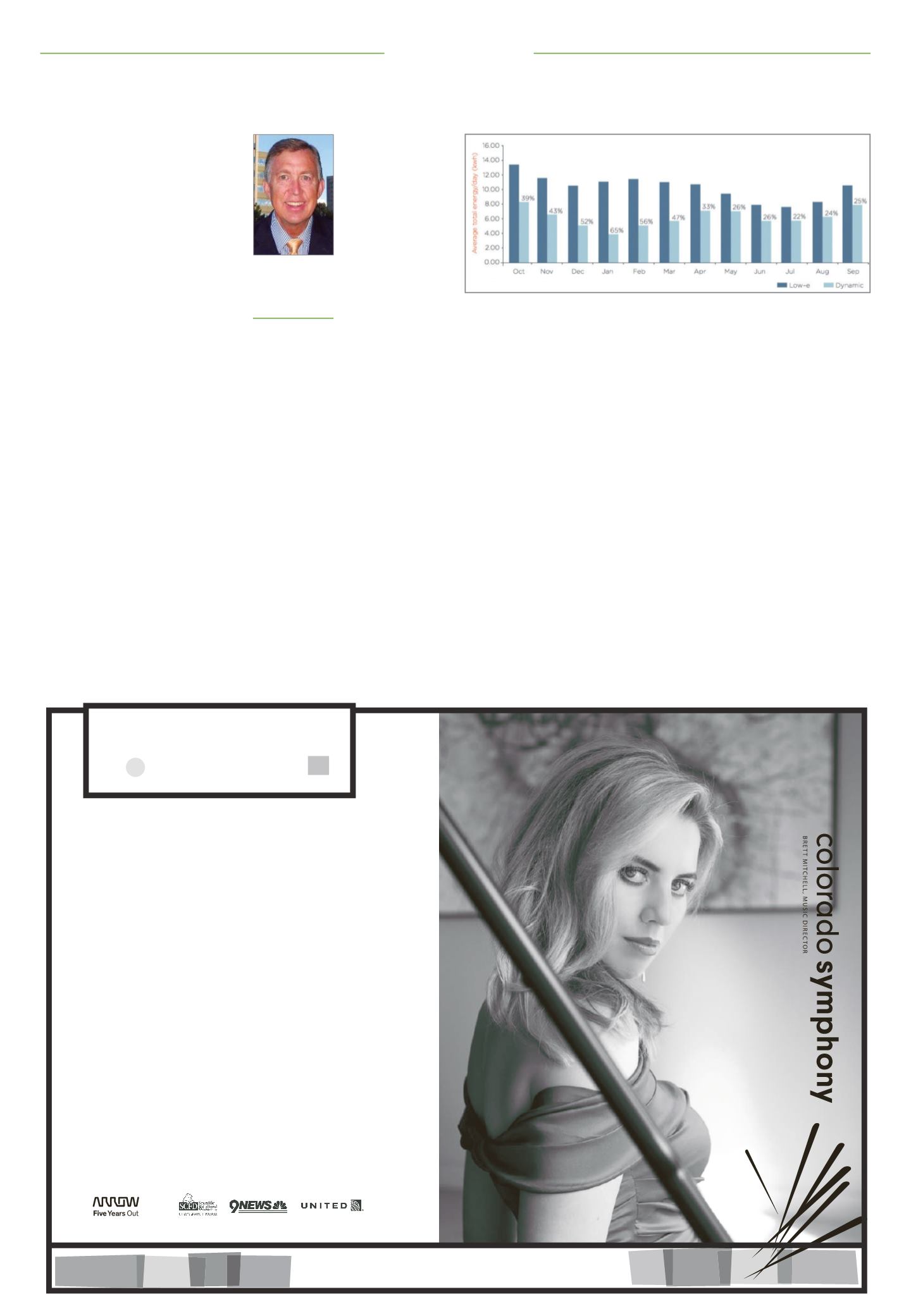

Page 24
— Office Properties Quarterly — September 2017
www.crej.comTechnology
T
he top complaints from tenants
of nearly every office building is
that the space is too hot or too
cold, and window glare is too
intense, in which case shades
are used that end up blocking high-
rent views.
Trying to regulate the temperature
and glare inside office buildings is
a constant battle, especially in a
semi-arid climate like Denver with
wide variations in temperature and
very intense sunshine. Even on cold
days, the cooling system is work-
ing hard to counteract multiple
heat sources, including lights, body
heat and equipment. However, the
largest-single source of heat gain
inside a building with an abundance
of windows typically is heat from the
windows.
To combat these issues, often an
insulated, double-pane window with
a static tinted low-e coating (not a
film) is used to reduce solar heat
gain by about 60 to 70 percent and
reduce glare by about 40 percent.
This performance is fixed, regardless
of the changes in outside heat and
light levels.
A new window system, which uses
a dynamic (auto-adjusted) tinted
electrochromic glass coating (not a
film) in a double-panel window unit,
provides even greater reduction in
solar heat gain and glare because the
tint level is automatically adjusted
electronically as the sun moves in
order to provide up to 90 percent
reduction in heat gain and up to 99
percent reduction in glare. Each win-
dow is connected to a small central
computer in the building, which is
custom programmed to change the
tint level as the sun moves. A light
sensor on the roof
makes corrections
so the tint level is
not too dark on a
cloudy day.
We conducted
a building energy
study to compare
the energy reduc-
tion capabilities
of windows with
static tinted low-e
glass versus
dynamic tinted
electrochromic
glass with its con-
trol system. To demonstrate the
potential energy reduction benefits
for a typical office building, a study
site was prepared with two identi-
cal south-facing perimeter offices.
One was installed with the static tint
while the other had the dynamic tint
system.
Both offices were located on the
second floor of an office building
and were built with identical room
dimensions, ceiling lights, furniture
and HVAC systems. They were adja-
cent south-facing perimeter offices
and received the same level of sun
exposure. To maintain a controlled
environment, both rooms were unoc-
cupied during the duration of the
monitoring period. Both rooms were
tied to a building automation soft-
ware platform used to control and
calculate energy consumption. The
lighting and HVAC occupancy sched-
ule stayed active from 7 a.m. to 7
p.m. on weekdays.
The proprietary intelligence control
package of the dynamic tinted elec-
trochromic glass system was imple-
mented into the demo room starting
October 2012. The intelligence pack-
age used geometrical solar penetra-
tion, radiated energy and real-time
environmental condition monitor-
ing to automatically change the tint
state of the glass for optimal solar
control and comfort, without win-
dow blinds/shades.
Prior to installing the dynamic
tinted electrochromic glass system
in demo room B, it was necessary to
ensure that both rooms were receiv-
ing identical solar radiation expo-
sure and room performance (HVAC,
insulation and lighting). Therefore,
both rooms were initially fitted with
the same static tinted low-e glass
and monitored for two weeks. The
sensors and controls were calibrated
and tuned to identical parameters.
The resulting data showed there
was less than a 2 percent difference
between the two rooms.
After 12 months of data collected,
it was found that the dynamic tinted
electrochromic glass system resulted
in 39 percent total energy savings.
Figure 1 shows the average total
energy use from October 2012 to Sep-
tember 2013. Under glare conditions,
which typically relate to high radia-
tion, the electrochromic glass system
transitions to the fully tinted state,
blocking 90 percent of the solar heat
entering the space, resulting in sig-
nificant cooling savings. In its fully
tinted state, demo room B required
slightly more artificial lighting to
maintain desired light levels. How-
ever, the additional energy required
for lighting was negligible compared
to the total cooling energy saved.
On the weekends, the electro-
chromic system resulted in an 85
percent cooling savings, as shown in
Figure 2 on Page 31, which shows the
total energy used during one of the
summer weeks in August. Results
reveal significant savings during the
weekend due to the weekend cool-
ing setback set point. On weekdays,
the cooling set point is 73 degrees
Fahrenheit, meaning cool air will be
supplied to the room once it detects
a temperature of 73° F or higher. It
is common to raise the setback tem-
Dynamic tinting combats common office complaintsMarty Slaught
Colorado sales
executive, View
Dynamic Glass,
Denver
Please see ‘Slaught’ Page 31Figure 1: The average total energy used in the case study from October 2012 to
September 2013.
TICKET
S COLORADOSYMPHONY.ORGCOMING SOON
Rachmaninoff’s Piano Concerto No. 3
with Natasha Paremski
NOV 17-19
FRI-SAT 7:30
■
SUN 1:00
Andrew Litton, conductor
Natasha Paremski, piano
LIADOV
The Enchanted Lake
, Op. 62
RACHMANINOFF
Piano Concerto No. 3 in D minor, Op. 30
PROKOFIEV
Symphony No. 5 in B-flat major, Op. 100
Natasha Paremski graces the stage once more to artfully present
Rachmanino ’s Piano Concerto No. 3. This piece is as elegant as it is
foreboding: it’s considered one of the most technically challenging
classical piano concertos, and is approached by even the most
accomplished pianists with trepidation. Proko ev’s delightful
Symphony No. 5 is a cheerful cap to a night of dazzling Russian
virtuosity, interpreted and conducted by famed Colorado Symphony
Principal Guest Conductor Andrew Litton.
presenting sponsor
colorado symphony proudly supported by
















